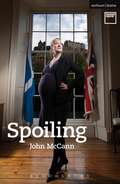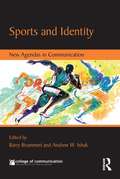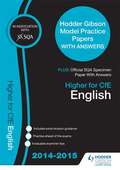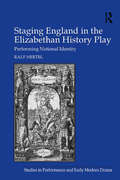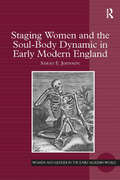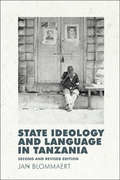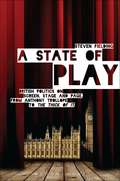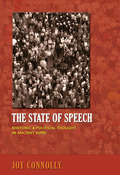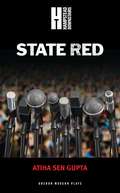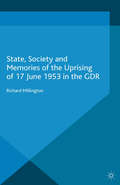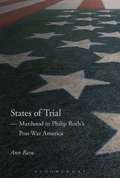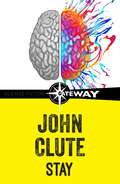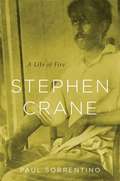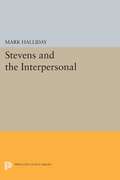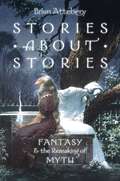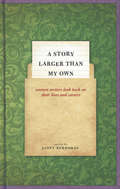- Table View
- List View
Spoiling (Modern Plays)
by John McCannI'd always been interested in the referendum. Followed every bit of it. Was as surprised as anybody at the result. When I saw that they needed new people for the transition, experienced people, I jumped at the chance.Scotland has gained independence. It's the eve of the Scottish Foreign Minister giving her first public address and in half an hour she is due to make a keynote speech outlining the nation's relationship with its neighbours in the former UK. There is a problem. Aside from being on the brink of giving birth, she is refusing to speak the form of words she's been given. She has something else she wants to say. Spoiling is a brilliant political comedy that boldly and humorously deals with some inflammatory issues. It is the only one in fifty plays by the Traverse's writers to receive a full commission in 2014. It received its world premiere at the Traverse Theatre on 28 July 2014.
Sports and Identity: New Agendas in Communication (New Agendas in Communication Series)
by Barry Brummett Andrew W. IshakThis volume of essays examines the ways in which sports have become a means for the communication of social identity in the United States. The essays included here explore the question, How is identity engaged in the performance and spectatorship of sports? Defining sports as the whole range of mediated professional sports, and considering actual participation in sports, the chapters herein address a varied range of ways in which sports as a cultural entity becomes a site for the creation and management of symbolic components of identity. Originating in the New Agendas in Communication symposium sponsored by the University of Texas College of Communication, this volume provides contemporary explorations of sports and identity, highlighting the perspectives of up-and-coming scholars and researchers. It has much to offer readers in communication, sociology of sport, human kinetics, and related areas.
Sports and Identity: New Agendas in Communication (New Agendas in Communication Series)
by Barry Brummett Andrew IshakThis volume of essays examines the ways in which sports have become a means for the communication of social identity in the United States. The essays included here explore the question, How is identity engaged in the performance and spectatorship of sports? Defining sports as the whole range of mediated professional sports, and considering actual participation in sports, the chapters herein address a varied range of ways in which sports as a cultural entity becomes a site for the creation and management of symbolic components of identity. Originating in the New Agendas in Communication symposium sponsored by the University of Texas College of Communication, this volume provides contemporary explorations of sports and identity, highlighting the perspectives of up-and-coming scholars and researchers. It has much to offer readers in communication, sociology of sport, human kinetics, and related areas.
SQA National 4 and 5 English (SQA National 4 & #5)
by Jane CooperEnsure your students are prepared for every aspect of their assessment with the only textbook endorsed by SQA and that offers fully comprehensive coverage of the new syllabus requirements. Written by a highly experienced author, it covers the new specification with all the new topics in the SQA examinations. The book provides thorough exam preparation, with graded Practice Exercises and is organised to make it easy to plan, manage and monitor student progress.
SQA Specimen Paper 2014 Higher for CfE English and Hodder Gibson Model Papers (PDF)
by SqaContains study skill advice, specimen question papers, model papers and answers.
Staging England in the Elizabethan History Play: Performing National Identity
by Ralf HertelApplying current political theory on nationhood as well as methods established by recent performance studies, this study sheds new light on the role the public theatre played in the rise of English national identity around 1600. It situates selected history plays by Shakespeare and Marlowe in the context of non-fictional texts (such as historiographies, chorographies, political treatises, or dictionary entries) and cultural artefacts (such as maps or portraits), and thus highlights the circulation, and mutation, of national thought in late sixteenth-century culture. At the same time, it goes beyond a New Historicist approach by foregrounding the performative surplus of the theatre event that is so essential for the shaping of collective identity. How, this study crucially asks, does the performative art of theatre contribute to the dynamics of the formation of national identity? Although theories about the nature of nationalism vary, a majority of theorists agree that notions of a shared territory and history, as well as questions of religion, class and gender play crucial roles in the shaping of national identity. These factors inform the structure of this book, and each is examined individually. In contrast to existing publications, this inquiry does not take for granted a pre-existing national identity that simply manifested itself in the literary works of the period; nor does it proceed from preconceived notions of the playwrights’ political views. Instead, it understands the early modern stage as an essentially contested space in which conflicting political positions are played off against each other, and it inquires into how the imaginative work of negotiating these stances eventually contributed to a rising national self-awareness in the spectators.
Staging England in the Elizabethan History Play: Performing National Identity (Studies In Performance And Early Modern Drama Ser.)
by Ralf HertelApplying current political theory on nationhood as well as methods established by recent performance studies, this study sheds new light on the role the public theatre played in the rise of English national identity around 1600. It situates selected history plays by Shakespeare and Marlowe in the context of non-fictional texts (such as historiographies, chorographies, political treatises, or dictionary entries) and cultural artefacts (such as maps or portraits), and thus highlights the circulation, and mutation, of national thought in late sixteenth-century culture. At the same time, it goes beyond a New Historicist approach by foregrounding the performative surplus of the theatre event that is so essential for the shaping of collective identity. How, this study crucially asks, does the performative art of theatre contribute to the dynamics of the formation of national identity? Although theories about the nature of nationalism vary, a majority of theorists agree that notions of a shared territory and history, as well as questions of religion, class and gender play crucial roles in the shaping of national identity. These factors inform the structure of this book, and each is examined individually. In contrast to existing publications, this inquiry does not take for granted a pre-existing national identity that simply manifested itself in the literary works of the period; nor does it proceed from preconceived notions of the playwrights’ political views. Instead, it understands the early modern stage as an essentially contested space in which conflicting political positions are played off against each other, and it inquires into how the imaginative work of negotiating these stances eventually contributed to a rising national self-awareness in the spectators.
Staging Women and the Soul-Body Dynamic in Early Modern England
by Sarah E. JohnsonThough the gender-coded soul-body dynamic lies at the root of many negative and disempowering depictions of women, Sarah Johnson here argues that it also functions as an effective tool for redefining gender expectations. Building on past criticism that has concentrated on the debilitating cultural association of women with the body, she investigates dramatic uses of the soul-body dynamic that challenge the patriarchal subordination of women. Focusing on two tragedies, two comedies, and a small selection of masques, from approximately 1592-1614, Johnson develops a case for the importance of drama to scholarly considerations of the soul-body dynamic, which habitually turn to devotional works, sermons, and philosophical and religious treatises to elucidate this relationship. Johnson structures her discussion around four theatrical relationships, each of which is a gendered relationship analogous to the central soul-body dynamic: puppeteer and puppet, tamer and tamed, ghost and haunted, and observer and spectacle. Through its thorough and nuanced readings, this study redefines one of the period’s most pervasive analogies for conceptualizing women and their relations to men as more complex and shifting than criticism has previously assumed. It also opens a new interpretive framework for reading representations of women, adding to the ongoing feminist re-evaluation of the kinds of power women might actually wield despite the patriarchal strictures of their culture.
Staging Women and the Soul-Body Dynamic in Early Modern England
by Sarah E. JohnsonThough the gender-coded soul-body dynamic lies at the root of many negative and disempowering depictions of women, Sarah Johnson here argues that it also functions as an effective tool for redefining gender expectations. Building on past criticism that has concentrated on the debilitating cultural association of women with the body, she investigates dramatic uses of the soul-body dynamic that challenge the patriarchal subordination of women. Focusing on two tragedies, two comedies, and a small selection of masques, from approximately 1592-1614, Johnson develops a case for the importance of drama to scholarly considerations of the soul-body dynamic, which habitually turn to devotional works, sermons, and philosophical and religious treatises to elucidate this relationship. Johnson structures her discussion around four theatrical relationships, each of which is a gendered relationship analogous to the central soul-body dynamic: puppeteer and puppet, tamer and tamed, ghost and haunted, and observer and spectacle. Through its thorough and nuanced readings, this study redefines one of the period’s most pervasive analogies for conceptualizing women and their relations to men as more complex and shifting than criticism has previously assumed. It also opens a new interpretive framework for reading representations of women, adding to the ongoing feminist re-evaluation of the kinds of power women might actually wield despite the patriarchal strictures of their culture.
State Ideology and Language in Tanzania: Second and revised edition
by Jan BlommaertThis book is a thoroughly revised version of the 1999 edition, which was welcomed at the time as a classic. It now extends the period of coverage to 2012 and includes an entirely new chapter on current developments, making this updated edition an essential read for students and scholars in language, linguistics and African Studies.
A State of Play: British Politics on Screen, Stage and Page, from Anthony Trollope to <i>The Thick of It</i> (Criminal Practice Ser.)
by Steven FieldingA State of Play explores how the British have imagined their politics, from the parliament worship of Anthony Trollope to the cynicism of The Thick of It. In an account that mixes historical with political analysis, Steven Fielding argues that fictional depictions of politics have played an important but insidious part in shaping how the British think about their democracy and have helped ventilate their many frustrations with Westminster. He shows that dramas and fictions have also performed a significant role in the battle of ideas, in a way undreamt of by those who draft party manifestos. The book examines the work of overtly political writers have treated the subject, discussing the novels of H.G. Wells, the comedy series Yes, Minister and the plays of David Hare. However, it also assesses how less obvious sources, such as the films of George Formby, the novels of Agatha Christie, the Just William stories and situation comedies like Steptoe and Son, have reflected on representative democracy. A State of Play is an invaluable, distinctive and engaging guide to a new way of thinking about Britain's political past and present.
The State of Speech: Rhetoric and Political Thought in Ancient Rome
by Joy ConnollyRhetorical theory, the core of Roman education, taught rules of public speaking that are still influential today. But Roman rhetoric has long been regarded as having little important to say about political ideas. The State of Speech presents a forceful challenge to this view. The first book to read Roman rhetorical writing as a mode of political thought, it focuses on Rome's greatest practitioner and theorist of public speech, Cicero. Through new readings of his dialogues and treatises, Joy Connolly shows how Cicero's treatment of the Greek rhetorical tradition's central questions is shaped by his ideal of the republic and the citizen. Rhetoric, Connolly argues, sheds new light on Cicero's deepest political preoccupations: the formation of individual and communal identity, the communicative role of the body, and the "unmanly" aspects of politics, especially civility and compromise. Transcending traditional lines between rhetorical and political theory, The State of Speech is a major contribution to the current debate over the role of public speech in Roman politics. Instead of a conventional, top-down model of power, it sketches a dynamic model of authority and consent enacted through oratorical performance and examines how oratory modeled an ethics of citizenship for the masses as well as the elite. It explains how imperial Roman rhetoricians reshaped Cicero's ideal republican citizen to meet the new political conditions of autocracy, and defends Ciceronian thought as a resource for contemporary democracy.
The State of Speech: Rhetoric and Political Thought in Ancient Rome
by Joy ConnollyRhetorical theory, the core of Roman education, taught rules of public speaking that are still influential today. But Roman rhetoric has long been regarded as having little important to say about political ideas. The State of Speech presents a forceful challenge to this view. The first book to read Roman rhetorical writing as a mode of political thought, it focuses on Rome's greatest practitioner and theorist of public speech, Cicero. Through new readings of his dialogues and treatises, Joy Connolly shows how Cicero's treatment of the Greek rhetorical tradition's central questions is shaped by his ideal of the republic and the citizen. Rhetoric, Connolly argues, sheds new light on Cicero's deepest political preoccupations: the formation of individual and communal identity, the communicative role of the body, and the "unmanly" aspects of politics, especially civility and compromise. Transcending traditional lines between rhetorical and political theory, The State of Speech is a major contribution to the current debate over the role of public speech in Roman politics. Instead of a conventional, top-down model of power, it sketches a dynamic model of authority and consent enacted through oratorical performance and examines how oratory modeled an ethics of citizenship for the masses as well as the elite. It explains how imperial Roman rhetoricians reshaped Cicero's ideal republican citizen to meet the new political conditions of autocracy, and defends Ciceronian thought as a resource for contemporary democracy.
State Red (Oberon Modern Plays)
by Atiha Sen Gupta‘You have to realise your decisions have consequences not only for you but for all of us – most of all your father!’ It’s late. Richard and Joyce have just returned home from the House of Lords – another boozy, gruelling but important social event that further cements Richard’s chance of being promoted to Commissioner of the Metropolitan Police. To their astonishment, and relief, they find their estranged son, Luke, fast asleep upstairs. After a year’s absence – and with only one email letting them know he was safe – where has he been? More importantly, why has he come back? And will Luke’s demons play hell with Richard’s promotion?
State, Society and Memories of the Uprising of 17 June 1953 in the GDR
by R. MillingtonCondemned as a fascist putsch in the East and praised as a 'people's uprising' in the West, the uprising of 17 June 1953 shook East Germany. Drawing on interviews and archive research, this book examines East German citizens' memories of the unrest and reflects on the nature of state power in the GDR.
States of Trial: Manhood in Philip Roth’s Post-War America
by Ann BasuThis study of five towering Philip Roth novels - Operation Shylock, the American Pastoral trilogy, and The Plot Against America - explores his vision of a turbulent post-war America personified in trial-racked Jewish American men. These works collectively register the impact of post-1945 upheavals upon the nation and American trial-based myths about wholesomeness and regeneration. Roth shows how the "stories of old" which moulded American self-making have produced disorderly and disruptive counter-stories, playing themselves out in Jewish men marked by spots and stains where their constitutional integrity has been infringed. Roth probes the nation's own constitutional testing points as he shatters the identities of characters such as fallen ace athlete Swede Levov and disgraced academic Coleman Silk. His books seek to strip away America's false innocence, demanding that historical accountability should replace myths of new beginnings. Creating arenas of trial for his American men where national discourses and narratives cross and clash, Roth's novels reveal that a culture equals its debates and allow us to see Americans and America as ongoing experiments, always being tested.
States of Trial: Manhood in Philip Roth’s Post-War America
by Ann BasuThis study of five towering Philip Roth novels - Operation Shylock, the American Pastoral trilogy, and The Plot Against America - explores his vision of a turbulent post-war America personified in trial-racked Jewish American men. These works collectively register the impact of post-1945 upheavals upon the nation and American trial-based myths about wholesomeness and regeneration. Roth shows how the "stories of old" which moulded American self-making have produced disorderly and disruptive counter-stories, playing themselves out in Jewish men marked by spots and stains where their constitutional integrity has been infringed. Roth probes the nation's own constitutional testing points as he shatters the identities of characters such as fallen ace athlete Swede Levov and disgraced academic Coleman Silk. His books seek to strip away America's false innocence, demanding that historical accountability should replace myths of new beginnings. Creating arenas of trial for his American men where national discourses and narratives cross and clash, Roth's novels reveal that a culture equals its debates and allow us to see Americans and America as ongoing experiments, always being tested.
Stay
by John CluteStay gathers together 100,000 words of reviews, plus short fiction by John Clute, and was originally published to coincide with Loncon3 (the 2014 World Science Fiction Convention) at which he was one of the Guests of Honour.Also included is a complete reprint of the text of The Darkening Garden.
Stephen Crane: A Life Of Fire
by Paul SorrentinoStephen Crane's short, compact life--"a life of fire," he called it--is surrounded by myths, distortions, and fabrications. Paul Sorrentino has sifted through garbled chronologies and contradictory eyewitness accounts, scoured the archives, and followed in Crane's footsteps. The result is the most accurate account of the poet and novelist to date.
Stephen Crane: A Life Of Fire
by Paul SorrentinoStephen Crane's short, compact life--"a life of fire," he called it--is surrounded by myths, distortions, and fabrications. Paul Sorrentino has sifted through garbled chronologies and contradictory eyewitness accounts, scoured the archives, and followed in Crane's footsteps. The result is the most accurate account of the poet and novelist to date.
Stevens and the Interpersonal
by Mark HallidayWith Wallace Stevens emerging as a father figure for American poetry of the late twentieth century, Mark Halliday argues that it is time for this "poet of ideas" to undergo an ethical critique. In this bold, accessible reconsideration of Stevens' work, he insists on the importance of interpersonal relations in any account of human life in the modern world. Although Stevens outwardly denies aspects of life that center on such relations as those between friends, lovers, family members, and political constituents, Halliday uncovers in his poetry an anxious awareness of the importance of these relations. Here we see the difficulties Stevens made for himself in wanting to offer a thoroughly satisfying version of secular spiritual health in the modern world without facing up to the moral and psychological implications of his own interpersonal needs, problems, and responsibilities. The final chapter reveals, however, an unusually encouraging "avuncular" attitude toward the reader of the poetry, which may be felt to redeem Stevens from the alienation observed earlier. Halliday develops his views by way of comparisons between Stevens and other poets, especially Thomas Hardy, Emily Dickinson, Robert Frost, and John Ashbery.Originally published in 1991.The Princeton Legacy Library uses the latest print-on-demand technology to again make available previously out-of-print books from the distinguished backlist of Princeton University Press. These editions preserve the original texts of these important books while presenting them in durable paperback and hardcover editions. The goal of the Princeton Legacy Library is to vastly increase access to the rich scholarly heritage found in the thousands of books published by Princeton University Press since its founding in 1905.
Stories about Stories: Fantasy and the Remaking of Myth
by Brian AtteberyMyth is oral, collective, sacred, and timeless. Fantasy is a modern literary mode and a popular entertainment. Yet the two have always been inextricably intertwined. Stories about Stories examines fantasy as an arena in which different ways of understanding myth compete and new relationships with myth are worked out. The book offers a comprehensive history of the modern fantastic as well as an argument about its nature and importance. Specific chapters cover the origins of fantasy in the Romantic search for localized myths, fantasy versions of the Modernist turn toward the primitive, the post-Tolkienian exploration of world mythologies, post-colonial reactions to the exploitation of indigenous sacred narratives by Western writers, fantasies based in Christian belief alongside fundamentalist attempts to stamp out the form, and the emergence of ever-more sophisticated structures such as metafiction through which to explore mythic constructions of reality.
A Story Larger than My Own: Women Writers Look Back on Their Lives and Careers
by Janet BurrowayIn 1955, Maxine Kumin submitted a poem to the Saturday Evening Post. “Lines on a Half-Painted House” made it into the magazine—but not before Kumin was asked to produce, via her husband’s employer, verification that the poem was her original work. Kumin, who went on to win the Pulitzer Prize for poetry, was part of a groundbreaking generation of women writers who came of age during the midcentury feminist movement. By challenging the status quo and ultimately finding success for themselves, they paved the way for future generations of writers. In A Story Larger than My Own, Janet Burroway brings together Kumin, Julia Alvarez, Jane Smiley, Erica Jong, and fifteen other accomplished women of this generation to reflect on their writing lives. The essays and poems featured in this collection illustrate that even writers who achieve critical and commercial success experience a familiar pattern of highs and lows over the course of their careers. Along with success comes the pressure to sustain it, as well as a constant search for subject matter, all too frequent crises of confidence, the challenges of a changing publishing scene, and the difficulty of combining writing with the ordinary stuff of life—family, marriage, jobs. The contributors, all now over the age of sixty, also confront the effects of aging, with its paradoxical duality of new limitations and newfound freedom. Taken together, these stories offer advice from experience to writers at all stages of their careers and serve as a collective memoir of a truly remarkable generation of women.
A Story Larger than My Own: Women Writers Look Back on Their Lives and Careers
by Janet BurrowayIn 1955, Maxine Kumin submitted a poem to the Saturday Evening Post. “Lines on a Half-Painted House” made it into the magazine—but not before Kumin was asked to produce, via her husband’s employer, verification that the poem was her original work. Kumin, who went on to win the Pulitzer Prize for poetry, was part of a groundbreaking generation of women writers who came of age during the midcentury feminist movement. By challenging the status quo and ultimately finding success for themselves, they paved the way for future generations of writers. In A Story Larger than My Own, Janet Burroway brings together Kumin, Julia Alvarez, Jane Smiley, Erica Jong, and fifteen other accomplished women of this generation to reflect on their writing lives. The essays and poems featured in this collection illustrate that even writers who achieve critical and commercial success experience a familiar pattern of highs and lows over the course of their careers. Along with success comes the pressure to sustain it, as well as a constant search for subject matter, all too frequent crises of confidence, the challenges of a changing publishing scene, and the difficulty of combining writing with the ordinary stuff of life—family, marriage, jobs. The contributors, all now over the age of sixty, also confront the effects of aging, with its paradoxical duality of new limitations and newfound freedom. Taken together, these stories offer advice from experience to writers at all stages of their careers and serve as a collective memoir of a truly remarkable generation of women.
A Story Larger than My Own: Women Writers Look Back on Their Lives and Careers
by Janet BurrowayIn 1955, Maxine Kumin submitted a poem to the Saturday Evening Post. “Lines on a Half-Painted House” made it into the magazine—but not before Kumin was asked to produce, via her husband’s employer, verification that the poem was her original work. Kumin, who went on to win the Pulitzer Prize for poetry, was part of a groundbreaking generation of women writers who came of age during the midcentury feminist movement. By challenging the status quo and ultimately finding success for themselves, they paved the way for future generations of writers. In A Story Larger than My Own, Janet Burroway brings together Kumin, Julia Alvarez, Jane Smiley, Erica Jong, and fifteen other accomplished women of this generation to reflect on their writing lives. The essays and poems featured in this collection illustrate that even writers who achieve critical and commercial success experience a familiar pattern of highs and lows over the course of their careers. Along with success comes the pressure to sustain it, as well as a constant search for subject matter, all too frequent crises of confidence, the challenges of a changing publishing scene, and the difficulty of combining writing with the ordinary stuff of life—family, marriage, jobs. The contributors, all now over the age of sixty, also confront the effects of aging, with its paradoxical duality of new limitations and newfound freedom. Taken together, these stories offer advice from experience to writers at all stages of their careers and serve as a collective memoir of a truly remarkable generation of women.
